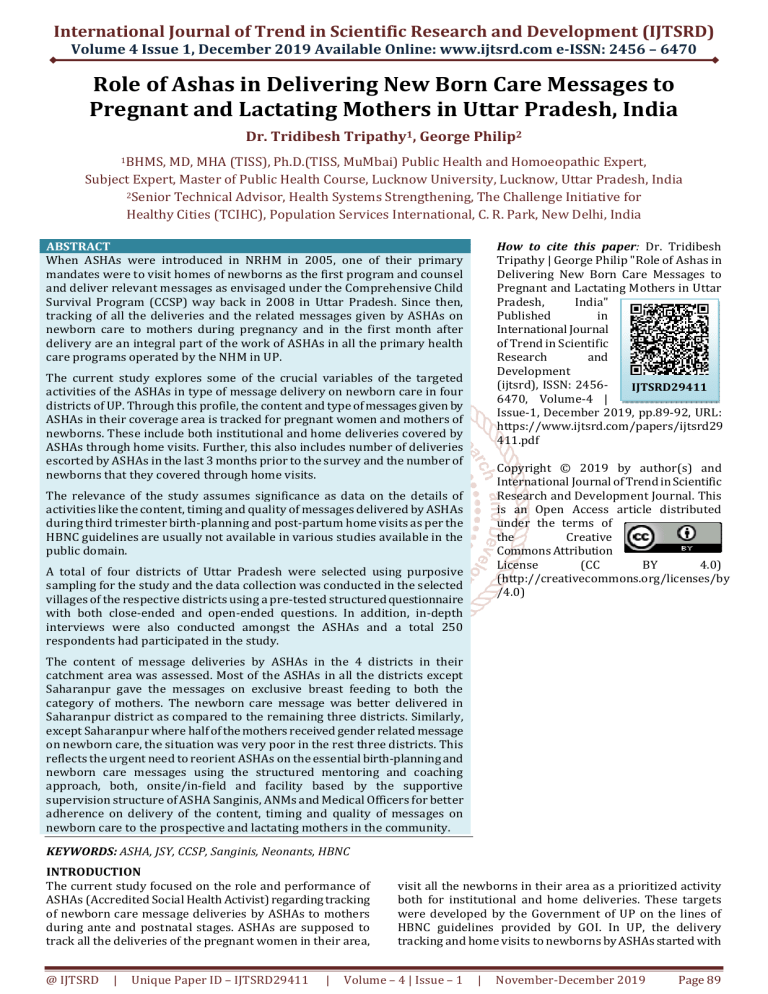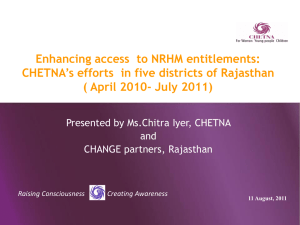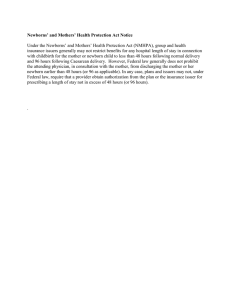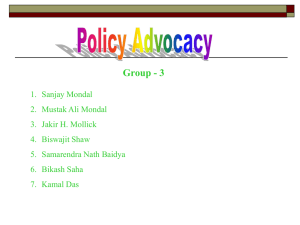
International Journal of Trend in Scientific Research and Development (IJTSRD)
Volume 4 Issue 1, December 2019 Available Online: www.ijtsrd.com e-ISSN: 2456 – 6470
Role of Ashas in Delivering New Born Care Messages to
Pregnant and Lactating Mothers in Uttar Pradesh, India
Dr. Tridibesh Tripathy1, George Philip2
1BHMS,
MD, MHA (TISS), Ph.D.(TISS, MuMbai) Public Health and Homoeopathic Expert,
Subject Expert, Master of Public Health Course, Lucknow University, Lucknow, Uttar Pradesh, India
2Senior Technical Advisor, Health Systems Strengthening, The Challenge Initiative for
Healthy Cities (TCIHC), Population Services International, C. R. Park, New Delhi, India
ABSTRACT
When ASHAs were introduced in NRHM in 2005, one of their primary
mandates were to visit homes of newborns as the first program and counsel
and deliver relevant messages as envisaged under the Comprehensive Child
Survival Program (CCSP) way back in 2008 in Uttar Pradesh. Since then,
tracking of all the deliveries and the related messages given by ASHAs on
newborn care to mothers during pregnancy and in the first month after
delivery are an integral part of the work of ASHAs in all the primary health
care programs operated by the NHM in UP.
How to cite this paper: Dr. Tridibesh
Tripathy | George Philip "Role of Ashas in
Delivering New Born Care Messages to
Pregnant and Lactating Mothers in Uttar
Pradesh,
India"
Published
in
International Journal
of Trend in Scientific
Research
and
Development
(ijtsrd), ISSN: 2456IJTSRD29411
6470, Volume-4 |
Issue-1, December 2019, pp.89-92, URL:
https://www.ijtsrd.com/papers/ijtsrd29
411.pdf
The current study explores some of the crucial variables of the targeted
activities of the ASHAs in type of message delivery on newborn care in four
districts of UP. Through this profile, the content and type of messages given by
ASHAs in their coverage area is tracked for pregnant women and mothers of
newborns. These include both institutional and home deliveries covered by
ASHAs through home visits. Further, this also includes number of deliveries
escorted by ASHAs in the last 3 months prior to the survey and the number of
newborns that they covered through home visits.
Copyright © 2019 by author(s) and
International Journal of Trend in Scientific
Research and Development Journal. This
is an Open Access article distributed
under the terms of
the
Creative
Commons Attribution
License
(CC
BY
4.0)
(http://creativecommons.org/licenses/by
/4.0)
The relevance of the study assumes significance as data on the details of
activities like the content, timing and quality of messages delivered by ASHAs
during third trimester birth-planning and post-partum home visits as per the
HBNC guidelines are usually not available in various studies available in the
public domain.
A total of four districts of Uttar Pradesh were selected using purposive
sampling for the study and the data collection was conducted in the selected
villages of the respective districts using a pre-tested structured questionnaire
with both close-ended and open-ended questions. In addition, in-depth
interviews were also conducted amongst the ASHAs and a total 250
respondents had participated in the study.
The content of message deliveries by ASHAs in the 4 districts in their
catchment area was assessed. Most of the ASHAs in all the districts except
Saharanpur gave the messages on exclusive breast feeding to both the
category of mothers. The newborn care message was better delivered in
Saharanpur district as compared to the remaining three districts. Similarly,
except Saharanpur where half of the mothers received gender related message
on newborn care, the situation was very poor in the rest three districts. This
reflects the urgent need to reorient ASHAs on the essential birth-planning and
newborn care messages using the structured mentoring and coaching
approach, both, onsite/in-field and facility based by the supportive
supervision structure of ASHA Sanginis, ANMs and Medical Officers for better
adherence on delivery of the content, timing and quality of messages on
newborn care to the prospective and lactating mothers in the community.
KEYWORDS: ASHA, JSY, CCSP, Sanginis, Neonants, HBNC
INTRODUCTION
The current study focused on the role and performance of
ASHAs (Accredited Social Health Activist) regarding tracking
of newborn care message deliveries by ASHAs to mothers
during ante and postnatal stages. ASHAs are supposed to
track all the deliveries of the pregnant women in their area,
@ IJTSRD
|
Unique Paper ID – IJTSRD29411
|
visit all the newborns in their area as a prioritized activity
both for institutional and home deliveries. These targets
were developed by the Government of UP on the lines of
HBNC guidelines provided by GOI. In UP, the delivery
tracking and home visits to newborns by ASHAs started with
Volume – 4 | Issue – 1
|
November-December 2019
Page 89
International Journal of Trend in Scientific Research and Development (IJTSRD) @ www.ijtsrd.com eISSN: 2456-6470
the CCSP in 2008 operated through the National Rural
Health Mission (NRHM) that is currently operational in 18
states of India. Uttar Pradesh is one such state. The aspects
of newborn care messages covered here are both for the
pregnant women and mothers of newborns. In a way, it
examines the planning and implementation of home based
new born care by ASHAs. The study also explores the role of
ASHA in addressing gender issue while delivering these
messages. The study was done in four selected districts in
Uttar Pradesh (UP) and the reference period was 3 months
preceding the survey.
Background of ASHAs
The ASHAs emerged in India’s public health system during
the launch of NRHM in 2005 in the state of Uttar Pradesh
(GOI, 2005). The ASHAs were in fact inducted to NRHM with
the primary aim to roll out the JSY component of NRHM (GOI,
2005).
A study on evaluation of ASHAs in 2013 in UP reflects that
52.7% of pregnant women were registered in first trimester
of pregnancy. 97.4% of pregnant women were registered for
ANC by ASHAs. 98.2% pregnant women got support from
ASHAs. 90.4% of the pregnant women were escorted for
delivery by ASHAs and 97.06% of pregnant women were
escorted in case of complications to Government health
facility (GOUP, CCSP evaluation report, Vimarsh, 2013).
The performance of ASHAs in UP was also done in another
study. As per the study, 98% of ASHAs register pregnant
women, average number of pregnant women registered by
each ASHAs in UP was 22. Among the registered pregnant
women, 32% of deliveries were home deliveries. 93% of
deliveries of health facilities were accompanied by ASHAs
and 71% of home deliveries were attended by each ASHA
(Bajpai N, Dholakia R, 2011).
As per another project operated in UP from 2006 to 2012,
the final results mention that the percentage of mothers
reporting on the second visit to their newborns by ASHAs
increased from 21% in 2006 to 60% in 2012. Similarly, the
third visit increased from 8% to 40% (COP report, Vistaar
Project, 2013). As per the report, the first visit refers to a
visit by a doctor or ANM and not ASHA.
The above three studies do not reflect on the performance of
ASHAs with respect to their targets for their catchment area
nor to the content and quality of message delivery on
newborn care. The current study has the quality and content
for each of the variables on newborn care used in the study.
This study done in 2017 examines the profile of the timing
and content of newborn care related messages in the
coverage area of ASHA. It further examines the role of
gender in the delivery of messages as the role of ASHAs are
seen for both boys and girls. The data reveals if the ASHA has
asked the mother to take equal care of boy or girl both in
pregnancy stage of the mother and in the first month period
after delivery. Through the scrutiny of these message
delivery, it also shows whether the ASHAs have visited the
houses of all the pregnant women and newborns who are to
be escorted for these deliveries to institutions.
Research Methodology
Using purposive sampling technique, four districts were
chosen from the four different economic regions of UP,
namely Central, Eastern, Western and Bundelkhand. Further,
the Government of UP in 2009 categorized the districts as
per their development status using a composition of 36
indicators. Purposefully, the high developed district chosen
for the study is Saharanpur from the western region, the
medium developed district chosen for the study is Barabanki
from the central region, the low developed district chosen
for the study is Gonda from the eastern region and the very
low developed district chosen for the study is Banda from
the Bundelkhand region (GOUP, 2009).
In the next step, purposefully two blocks were selected from
each of the district and all the ASHAs in these blocks were
chosen as the universe for the study. From the list of all the
ASHAs in each of the two blocks, 31 ASHAs were chosen
randomly from each block for the study. In this way, 62
ASHAs were chosen for the study from each of the districts.
In Gonda district, 64 ASHAs were selected to make the total
number of ASHAs for the study to 250.
Data analysis
The data was analyzed using SPSS software to calculate the
percentage of mothers covered by ASHAs. The mothers of
newborns include the total number of deliveries that covers
both institutional and home deliveries. It also deciphered the
home-based newborn care of newborns visited by ASHAs
through content and timing of the messages. The analysis
also saw the messages through the gender lens. The study
also used the detail profiles of deliveries as per the data
collected in the four study districts. The qualitative data
related to the details of the contents of the messages given
during home visits to newborns and deliveries was seen
against the prescribed guidelines for ASHAs by GOI
regarding the content in the prescribed training modules of
ASHAs.
Research tool
The ASHAs were interviewed using an in-depth, open-ended
interview schedule which included a section on variables on
work done by ASHAs through home visits to newborns,
escorting deliveries to institutions, number of home
deliveries and number of newborns visited. These activities
were also seen against the targets that should be achieved by
the ASHAs to track the number of deliveries and visits to the
houses of number of newborns in the last 3 months
preceding the survey.
Results and discussions
In this section, there are two tables one for the details of newborn care messages to the pregnant women and the other for the
same messages to the mothers of newborns in the catchment areas of ASHAs. Usually, these are the women who are escorted
by ASHAs for deliveries that includes both institutional and the home deliveries in their coverage area. It captures the planning
as well as the execution of newborn care for number of newborns that the ASHAs visit. All these activities are for the reference
period of 3 months preceding the survey related to the study.
@ IJTSRD
|
Unique Paper ID – IJTSRD29411
|
Volume – 4 | Issue – 1
|
November-December 2019
Page 90
International Journal of Trend in Scientific Research and Development (IJTSRD) @ www.ijtsrd.com eISSN: 2456-6470
Table 1
Percentage of ASHAs delivering type of messages on newborn care during home visits to pregnant women
Names of districts
Banda
Barabanki
Gonda
Saharanpur
Dry and wrap up immediately after birth
33.3
58
54
98.3
Delay bathing the newborn for a week
37
56
46.5
91.5
Initiate breast feeding within an hour of birth
28
30
55.5
88.1
Exclusive breastfeeding up to 6 months
85
83
75
100
Do not apply anything on the cord
61
64
33
93.2
Get newborn weighed
8.5
3.4
4.5
81.3
Take equal care of girl/boy newborn
5.1
0.0
1.5
55.8
Any other
0.0
0.0
0.0
1.7
The table above mentions categories/types of messages on the newborn care. The current paragraph deals with the messages
that the pregnant women got from the ASHAs. The first message regarding drying and wrapping up the newborn after birth
was given by more than 98% of ASHAs in Saharanpur where as in Gonda only 54% and in Barabanki only 58% of ASHAs gave
this message which ensured the warmth of the newborn. In Banda, the least developed district among the four only 33% of
ASHAs gave this message. The pattern was same for the message of delaying birth for a week. Only 37% of ASHAs in Banda gave
this message followed by 46% in Gonda and 56% in Barabanki. Saharanpur had more than 90% of ASHAs who gave this
message to pregnant women. The message on early initiation of breast feeding was given by only 28% of ASHAs in Banda, 30%
in Barabanki, 55% in Gonda and again 88% in Saharanpur, the most developed district among the four districts. Interestingly,
the message related to exclusive breast feeding was on the higher side in all the districts. This message was given by all the
ASHAs in Saharanpur, more than 80% of ASHAs gave this message in Banda and Barabanki districts. The low category district
had 75% of ASHAs giving this message to pregnant women. The message regarding cord care where the ASHAs advised the
household to keep the cord clean by not applying anything on the cord showed a different picture. Only about 33% of ASHAs
gave this message in Gonda where as it was given by just more than 60% of ASHAs in Banda and Barabanki districts.
Saharanpur again led the list with more than 93% of ASHAs giving this message. The next message about weighing the
newborn was given by very few ASHAs in 3 districts except Saharanpur where more than 81% of ASHAs gave this message.
However, in Saharanpur only about 2% of ASHAs also gave non-specific messages to pregnant women regarding newborn care.
The last message in this category was the gender issue related message where ASHAs told the pregnant women to take equal
care of boy or girl was given by very few ASHAs in districts of Banda and Gonda. No ASHA in Barabanki percolated this message
whereas only about 56% of ASHAs in Saharanpur gave this message to pregnant women. In this section, we found that barring
Saharanpur, the ASHAs in other three districts were not giving newborn care messages to all pregnant women. The only
message of exclusive breast feeding showed a better pattern among the four districts.
Table 2
Percentage of ASHAs delivering type of messages on newborn care to mothers of newborns
Names of districts
Banda Barabanki Gonda Saharanpur
Keep the baby well wrapped and warm
33.8
66
54.6
95
Delay bathing the newborn for a week
32.2
41.9
29.6
96.7
Initiate breastfeeding within an hour of birth
27.4
24.1
76.5
87
Do not apply anything on the cord
74.1
72.5
28
93.5
Exclusive breastfeeding up to 6 months
96.7
91.9
81
95.1
Get newborn weighed
9.6
9.6
4.6
87
Danger signs in newborn
1.6
3.2
6.2
79
Danger signs in mother
3.2
0.0
0.0
56.4
This section dealt with the messages that the ASHAs gave regarding newborn care to the mothers of newborns. In addition to
the list of messages given to the pregnant women regarding newborn care, there were two more messages on danger signs
both for the mother and child. The gender related issue is not dealt here. The table shows that only 33% of ASHAs in Banda and
55% of ASHAs in Gonda told the mother to dry and wrap the newborn but 66% in Barabanki and 95% of ASHAs in Saharanpur
gave this message to mothers of newborns. The second message on maintaining the warmth of the newborn through delaying
the bathing was only given by 30% of ASHAs in Gonda and 32% in Banda districts. 42% of the ASHAs of Barabanki and about
97% of ASHAs in Saharanpur gave this message to pregnant women. Regarding messages related to breast feeding, 81% of
ASHAs gave this message in Gonda district and the same message was given by more than 90% of ASHAs in the rest 3 districts.
In contrast, the early initiation of breastfeeding message was given by 24% of ASHAs in Barabanki and 27% of ASHAs in Banda
district. Here, the ASHAs of Gonda and Saharanpur fared better as 77% and 87% of ASHAs give this message in these two
districts respectively. Cord care message was poorly done in Gonda as only 28% of ASHAs gave this message but more than
70% of ASHAs gave this message in Banda and Barabanki districts while Saharanpur topped the list with 93.5% ASHAs who
gave this message.
The message regarding weighing the newborn was given by just 5% of ASHAs in Gonda and about 10% of ASHAs in Banda and
Barabanki. The figure was better in Saharanpur where 87% of ASHAs gave this message to the mothers of newborns. Except
Saharanpur where 79% and 57% of ASHAs gave messages on danger signs in newborn and mother respectively, very few
ASHAs of the rest 3 districts disseminated this message.
In Barabanki and Gonda district, none of the ASHAs gave messages on danger signs in the mother.
@ IJTSRD
|
Unique Paper ID – IJTSRD29411
|
Volume – 4 | Issue – 1
|
November-December 2019
Page 91
International Journal of Trend in Scientific Research and Development (IJTSRD) @ www.ijtsrd.com eISSN: 2456-6470
Conclusions
The above results showed that the average content on
newborn care messages revolve around exclusive breast
feeding primarily. This was seen across three districts except
Saharanpur. The major problem is that the ASHAs do not
compare the performance with their targets as well as the
content of the message delivery. Tracking of all the pregnant
women and preparing them to take care of their newborns
through home based newborn care has to be planned by the
ASHAs. As all the deliveries are not tracked, the newborns
are also not tracked and that’s why all the newborns are not
visited by the ASHAs in all the districts. This is why the
mothers of newborns do not receive the newborn care
messages timely in the first month after delivery. The
challenge lies in mentoring-coaching ASHAs on following up
all the deliveries with the support of Sanginis (supervisors of
ASHAs in UP) and that too it should be preferably an onsite
orientation i.e. during the home visits while accompanying
the ASHAs. Qualitative analysis of the messages and effective
delivery of these messages are the two areas that the
supervisors need to focus. Message content along with the
@ IJTSRD
|
Unique Paper ID – IJTSRD29411
|
inclusion of gender issues will lead better sex ratios at birth
as well. All these parameters should be worked out at the
level of ASHAs so that performance is tracked regularly.
References
[1] Bajpai N, Dholakia R. (2011). Improving the
performance of ASHAs in India, working paper No.1,
working
paper
series,
globalcentres.
columbia.edu/southasia, 2011.
[2] Report on evaluation of CCSP and ASHA scheme in UP,
Vimarsh, SIFPSA, GOUP, 2013.
[3] GOI (2005, 2015). Ministry of Health and Family
Welfare; Update on the ASHA Programme, April 2005,
January 2015.
[4] Government of Uttar Pradesh (2009). Planning Atlas of
Uttar Pradesh; Area Planning Division, State Planning
Institute, Planning Department.
[5] Project Close-Out Report, The VISTAAR project, 20062012, Intra Health International, April, 2013.
Volume – 4 | Issue – 1
|
November-December 2019
Page 92





